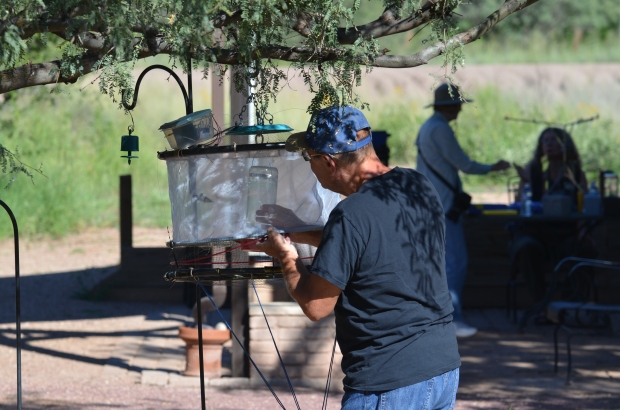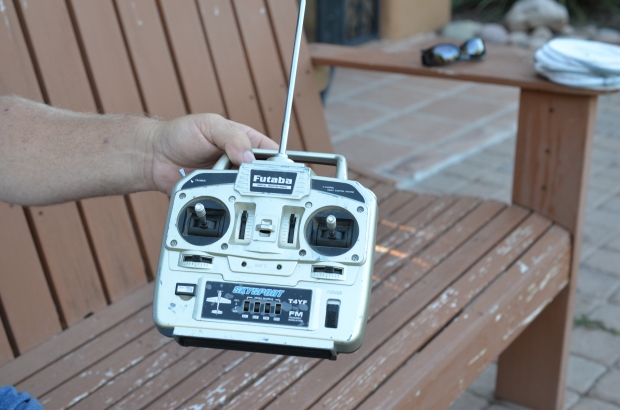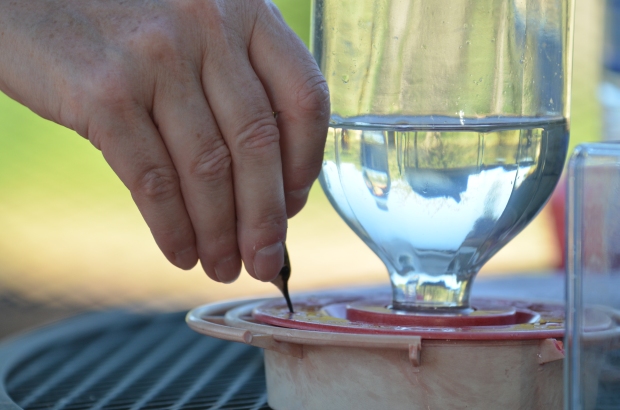What hummingbird banding teaches us
A hummingbird approaches the nectar feeder and just as its getting its drink a mesh bonnet unfolds into a drum and drops over the feeder, trapping the bird. A man sitting in a camp chair four yards away controls the bonnet from a remote-controlled radio system that’s designed for toy airplanes.
I walk with another volunteer over to the trapped bird where he reaches into the bonnet. He grabs it with his hand, hoping the bird doesn’t use its sharp beak as a weapon in defense. He puts it into a smaller quart-sized mesh container also in the shape of a little drum and I ask him where he got it.
“It’s a lingerie bag from Bed Bath and Beyond. There’s not a lot of equipment made just for hummingbird banding,” he says.
He lets me hold the bag and deliver it to Sheri Williamson, co-founder of the Southeastern Arizona Bird Observatory (SABO) and author of A Field Guide to the Hummingbirds of North America, who is sitting at a table set up outside near the feeder. In front of her is a scale, a log book and a small tray of very tiny aluminum bands she’ll put on the hummingbirds for tracking. She weighs the bird, measures its length and blows on its feathers with a straw to expose it’s stomach where she can tell how much fat it is carrying.
“One of the biggest challenges for migratory birds is the need for a stopover to fatten up and refuel,” Williams says.
Hummingbird banding is one of the tools used in avian research. It’s regulated by the Federal Government and requires a permit only trained experts can obtain. But with the help of SABO in Sierra Vista, Arizona, you can participate in hummingbird banding during the months of April, May, July, August and September (they take June off). They set up their “lab” at the San Pedro House Bed and Breakfast several times a week during those months. (Check out their website to find out dates and times.)
For 27 years SABO has been banding and recording data on over 500 hummingbirds each year near the San Pedro River conservation area. Their efforts track hummingbird migration schedules and reproductive cycles. This data informs scientists on how long the birds can live and also show the importance of a river as a critical migratory corridor.
To catch a hummingbird
Catching a hummingbird isn’t easy. It takes a feeder, a carefully engineered bonnet trap, a remote control radio system, and a dedicated group of volunteers who bring their passion and commitment every week to help study these birds. It also takes a special federal permit to do hummingbird banding since native birds are protected by the Migratory Bird Treaty Act, so you can’t do this yourself. You need to be a trained person holding a permit to do this.
SABO was founded by Naturalist/Directors and husband-wife team Tom Wood and Sheri Williamson. Sheri is well-known around the world as the expert ornithologist on hummingbirds and is the author of A Field Guide to Hummingbirds of North America in the Peterson Field Guide Series. Sheri ‘s unassuming, warm personality puts you instantly at ease. You have to be reminded that she’s highly sought out by bird experts and ornithologists for her deep understanding of hummingbirds with her pop-up banding lab in the middle of the southeastern Arizona desert. She and Tom live in nearby Bisbee, a little town that feels a little bit like a hippie haven, and seems to fit their laid-back personalities.
Part naturalist, part scientist, part jeweler
To call the bands “little” is an understatement. They are tiny strips of aluminum with numbers imprinted on them, provided by the American Ornithological Union (AOU). Channeling the skilled craftsman of a jeweler, Sheri and her team then have to cut up make them into tiny loops.
Bands aren’t one-size-fits-all. They have bands ready for the smallest hummingbird (the Calliope Hummingbird at 2 3/4″ in length) to the largest (the Blue-throated Hummingbird at 5 1/4″ in length) that fly through the San Pedro River conservation area. It’s this area that makes it attractive for banding and studying as it shows the importance of a river as a critical migratory corridor. “One of the biggest challenges in migratory birds is the need for a stopover to fatten up and refuel,” Tom reminds me.
SABO bands and records data on over 500 hummingbirds in a year. This enables the tracking of migration schedules and reproductive cycles, and lets us know how long birds can live. The more we can learn and know about birds the more we understand about the state of our environment and where things are in balance and where they’re off balance. Birds aren’t here just for our amusement and enjoyment, but they’re part of our planet’s delicate ecosystem. Just think food chain. No birds? Well, then be prepared to be up to your eyeballs in insects and resulting diseases.

This card shows the data for a female black-chinned hummingbird that has been recaptured two times after its original banding.
As Sheri inspects each hummingbird I marvel at two things: Sheri’s nurturing sense about her examination (“Oh, you’re a little one,” she coos). And that, with the exception of one that managed to escape, each bird remains still throughout the measuring, weighing and banding. “Oh, I just love hummingbirds. They’re so cute,” I say stupidly and ashamed that I couldn’t have chosen more sophisticated words around such knowledgeable people.
Sheri chuckles and then says, “Hummingbirds are the gateway drug to birding,” I nod my head in agreement. She then grabs a straw and puts it in her mouth and begins to blow lightly on the underside of a hummingbird and I see that her breath opens up the feathers, revealing a light, pink tummy. “What does that tell you?” I ask as I lean in to get a closer look. With the straw still in her mouth she tells me that it shows her how much fat it has.
The examination is now over for this little bird. Sheri then hands the bird to a volunteer standing by and I’m amazed that during the hand off the bird doesn’t escape their fingers and that they are able to do the whole thing gently. Every hummingbird is rewarded with a drink before they are let go. “It was the feeder they were coming for in the first place,” the volunteer explains as she holds the tiny bird between her thumb and fingers and swoops the bird down to the feeder like a mom playing airplane with a spoonful of baby food coming in for a landing in her toddler’s mouth. “It helps give the bird the feeling of flying in to get a drink.” the volunteer explained. “They’re more apt to drink that way.”
Time to go now
After each little hummer has had its drink, she places the bird in my hand and we go through this pattern of waiting as the bird contemplates if it’s now safe to take off. Some fly off after about 15 seconds and others need to muster up the courage to dart up into the blue sky. We repeat this process with several birds, with my husband and I each taking turns.
It’s during the precious little moment when the hummingbird is nestled in your hand that you realize someone has flipped a switch and turned everything off in the world. He’s not flitting around or buzzing near your ear like George Jetson. He’s quiet. He’s absolutely still. The frenetic pace of the world that matches the 80-times-per-second wing beats of the hummingbird have come to a screaching halt. Time has stopped and I wait for that moment for the little bird to signal that it’s ready, that it’s time to flip the switch back on.
And when it does, it’s magic. (Watch video below.)













Great article! We’ll be at Casa San Pedro in Arizoba at the end of this month to see the Hummingbird Banding! I hope I get to hold a hummingbird too!
Lynn
LikeLike
Oh you are so lucky! You will love Casa de San Pedro. We picked up steaks at the Tucson Costco, which was right near the airport and we grilled steaks on the BBQ at the B&B. I’ll be writing a post about the B&B as well, so look for that.
LikeLike
This sounds like an awesome place! BTW, I recently wrote to you to check out Dauphin Island, Alabama. A great local event coming up is the Alabama Coastal Birdfest, a 3-day weekend (Sep 30 – Oct 3) of various birding and nature trips. Bird banding used to be an event until the gentleman who headed up the group passed away last year. Several other great trips are still available, including to Dauphin Island for fall migration. I hope you and your readers will check it out! You can Google for the website and see the schedule.
LikeLiked by 1 person
Hi Angie! I mentioned to my husband the other day your recommendation to check out Dauphin Island. Not certain we can make it this year, because of another commitment, but we definitely will have to put it on our short list for next year. I’m going to check out the website RIGHT NOW. Thanks again!
-Lisa
LikeLike
I really enjoyed this post. Thanks for all the details and photos!
LikeLike
We did this for the first time last year. The kids loved it! Of course, I did too. ‘Gateway drug’ is right. Fantastic piece…thanks for sharing!
LikeLike
Pingback: The technicolor world of Bisbee, Arizona | The baby aspirin years
Pingback: Shout out to Bel-Rea Vet Tech School | The Accidental Birder
Pingback: Hummingbirds of Costa Rica | The Accidental Birder